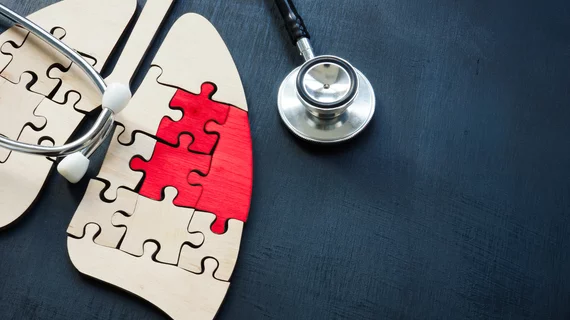COVID-19 survivors with diabetes may require long-term lung monitoring
COVID-19 survivors with diabetes may require long-term monitoring of lung abnormalities, according to new research published July 27 in Academic Radiology [1].
During the early stages of the pandemic, diabetes was associated with higher mortality, disease severity and worse prognosis. Chinese radiology experts sought to better understand the lasting effects of this phenomenon, conducting a prospective study among nearly 300 patients who had recovered from the coronavirus.
At the three-year mark, individuals with diabetes had higher incidence of respiratory symptoms, lung abnormalities on CT scans, and problems moving oxygen into the blood. Factors including diabetes, allergies, being female, fibrotic-like changes on chest imaging, and suffering severe COVID were all independent predictors of lingering lung problems, experts noted.
“These results highlight the long-term deleterious effect of diabetes status on radiological pulmonary abnormalities and pulmonary dysfunction in COVID-19 survivors,” Linxia Wu, MD, PhD, with the Department of Radiology at Union Hospital in Wuhan, China, and co-authors concluded. “This study provides important evidence support for long-term monitoring of lung abnormalities in COVID-19 recovery survivors with diabetes.”
Researchers recruited a total of 278 patients recovering from the virus for their multicenter study. They included 111 individuals with diabetes (97% had the Type 2 variety) and another 167 control subjects without the chronic metabolic disease. Subjects underwent serial chest CT scans, filled out symptom questionnaires and completed pulmonary function tests at 6 months, 1 year, 2 years and 3 years after hospital discharge. Age, gender and COVID-19 severity distribution were comparable between the two groups.
Among survivors with diabetes, nearly 30% had respiratory symptoms, 50% had reduced lung diffusion capacity for carbon monoxide, and 51% had radiological lung abnormalities at the three-year mark. All levels were higher than in the control group, the authors noted. CT changes such as bronchiectasis and honeycombing persisted through the study’s conclusion, potentially signaling “irreversible lung damage in survivors of COVID-19.”
Wu and colleagues referred to such damage as “fibrotic-like changes,” with a higher proportion appearing among the diabetes group compared to control subjects.
“The chronic inflammatory state associated with diabetes may have predisposed individuals to heightened susceptibility to damage induced by COVID-19,” the authors noted. “This could potentially initiate a detrimental cycle marked by cytokine release and hyperglycemic surges, setting COVID-19 participants with diabetes on a path toward poorer clinical outcomes.”
Previous studies have confirmed that COVID-19 survivors with preexisting diabetes have an increased risk of worsening disease, especially among those with poorly controlled HbA1c (> 8.6%), Wu and co-authors added.
“Despite various anti-diabetic treatments adopted by diabetic individuals in this study, their HbA1c and fasting plasma glucose remain higher than those without diabetes. This potentially leads to a higher proportion of persistent lung abnormalities in the group with diabetes,” the authors wrote.
Wu and colleagues cautioned that their dataset was small and specifically focused on unvaccinated individuals who weren’t infected with the original strain of COVID-19. Thus, the results may not apply to others who have encountered variant strains or been inoculated. Also, most subjects had Type 2 diabetes, with further research needed on those with the Type 1 variety.
Nevertheless: “These findings underscore the significance of prolonged monitoring and surveillance for the specific subset of COVID-19 recovery survivors with concurrent diabetes,” the study concluded.

